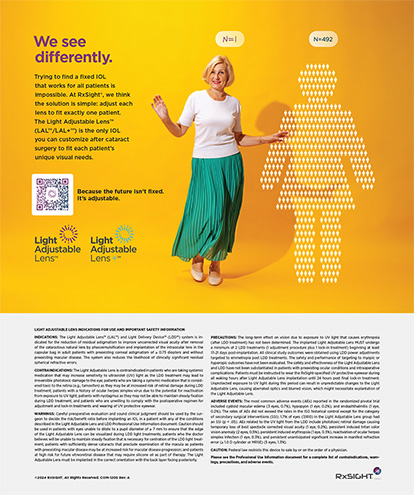One of the most devastating complications of cataract surgery is painful blindness due to bacterial endophthalmitis. The source of this iatrogenic complication is often undetermined, but the rate of bacterial endophthalmitis is on the rise. In light of the fact that most cataract surgery is now performed through clear or near-clear corneal incisions that are left unsutured, the consensus of surgeon opinion is that microleaks in the wound allow the ingress of bacteria during the postoperative period and thereby lead to bacterial endophthalmitis.
Our duty, then, is to ensure that our corneal incisions truly self-seal—not only when we test the wound at the end of the case, but throughout the first few days following surgery. Short of suturing the wound (a mandatory step for obviously leaking incisions), techniques to secure clear corneal incisions include re-forming the anterior chamber to close the posterior lip of the wound and stromal hydration of the sides of the wound.
This article describes an additional but very simple step to close incisions securely; it requires no extra instruments or expense, takes less than 30 seconds to perform, and helps prevent microleaks in the wound. The method is called stromal hydration of a supraincisional pocket, but it is colloquially referred to as the Wong Way.
WOUND ARCHITECTURE
Proper clear-corneal wound architecture is paramount to creating a well-sealed incision. Important factors include a relatively long tunnel as compared with the chord length, clean incisional edges without thermal burns, squared-off ?shoulders? of the wound, and a sufficient internal corneal lip. When an incision has all these characteristics, it will adequately seal upon the reforming of the anterior chamber. On those occasions when the incision is not sealed, the stromal hydration of a supraincisional pocket provides an extra level of security.
OTHER TECHNIQUES
Re-forming the anterior chamber to elevate the IOP will seal the wound, but it may lead to glaucomatous situations, particularly when viscoelastic material is inadvertently left in the eye. Moreover, the clear corneal incision that appears secure in the OR can become compromised after the IOP normalizes postoperatively. Another option for sealing the incision is to create a narrow wound, but this technique increases the risk of a corneal burn from the phaco handpiece. By contrast, lengthening the wound brings the internal aspect of the incision closer to the visual axis and impairs visualization during surgery. Stromal hydration of the sides of the incision can distort the wound architecture by upsetting point-to-point apposition, and LASIK experience teaches us that moist stromal surfaces are less adherent. Moreover, hydration at this peri-incisional level is more rapidly absorbed and thus may provide only a temporary seal.
Creating the Pocket
After starting the surgery with the usual knife-needle tract, the surgeon fills the anterior chamber with enough viscoelastic to make the globe firm. Just central or anterior to the surgeon's normal clear corneal or limbal incision site, he makes one or two stabs into the anterior stroma with a keratome. The goal is to create a triangular pocket (its tip toward the pupil) that is approximately 1.5 mm long, 1.5 to 2.0 mm wide, and one-third the stromal depth. If the surgeon uses two stabs, he places them side by side so that the incision resembles an upside-down “W” (Figure 1A).
Next, the surgeon performs a standard keratotomy with the starting point just peripheral to and the pass directly beneath the pocket (ie, deeper in the stroma) (Figure 1B). It is important to note that there is tremendous latitude in creating the pocket(s). Creating a pocket that is either slightly smaller or larger, that is to one side, or that even has an intersecting keratotomy and pocket will not compromise the pocket's effectiveness.
Closing the Wound
At the completion of a standard cataract procedure, the surgeon re-forms the anterior chamber, which creates upward pressure against the inner lip of the corneal wound. Using a 30-gauge cannula, he hydrates the tip and edges of the triangular, supraincisional stromal pocket(s) with BSS (Alcon Laboratories, Inc., Fort Worth, TX) until the stroma whitens (Figure 2A). In my experience, it is usually easier to find the opening of the pocket while the eye is slightly soft. This technique usually requires less fluid than other wound-hydration techniques. The resultant stromal bulge creates downward pressure against the exterior or superficial aspect of the corneal wound, and the incision is sandwiched by pressure from above and below (Figure 2B).
The edema surrounding the supraincisional pocket persists for 24 to 36 hours, because this fluid is on the superficial side of the corneal incision, removed from the endothelial pump action (the pump must snap shut the wound before it dries this pocket). The stromal surfaces of the clear corneal incision stay relatively dry and undistorted, which increases fluid-flow resistance across the wound. This technique prevents microleaks.
BENEFITS
A more secure corneal wound increases the margin of safety and reduces the pressure on surgeons to make the wound narrow and long. Initial keratotomy wounds that are 3.0 mm wide and 1.5 mm long close adequately, which reduces corneal distortion during surgery. This technique is excellent for cases in which the chosen IOL requires a wider corneal incision, because it can secure wounds up to 4.0 mm long. When compared with stromal hydration at the sides of a corneal incision, the Wong Way produces less central corneal edema postoperatively because it uses less fluid. In addition, the surgeon may leave the globe relatively soft at the end of the case, thereby decreasing the risk of IOP spikes that result from retained viscoelastic material.
CONCLUSION
Some surgeons have incorporated this technique into their standard operating procedure, whereas others use it only as they make the transition from scleral to clear corneal incisions. The supraincisional stromal pocket may also be used as a “save” at the conclusion of cases in which the soundness of the wound's seal is in doubt; unlike a suture, this method is less likely to create unwanted astigmatism.


